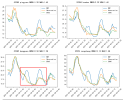Hi everyone.
I am currently simulating several cold spell events in eastern China using WRF-SLUCM. However, in some cases, we found that the model results poorly captured the temperature variations when compared to meteorological station observations.
As shown in the figure , the cold spell began around 2020-03-20. According to the observations, the temperature consistently dropped over the following two days. However, in the WRF results, the temperature dropped more sharply between March 20 and 21, followed by an unrealistic daytime warming on March 21. Similarly, on March 22, the simulated daytime warming was more intense than observed. These results suggest that the WRF simulation failed to accurately reflect the temperature trend during this cold spell event. I believe that the issue may stem from WRF-SLUCM itself, rather than the boundary conditions, since the ERA5 forcing data generally aligns well with the actual observations.

My goal here is to seek potential solutions for improving the performance of WRF-SLUCM in capturing such events. I would greatly appreciate any suggestions or insights.
The experiment details are as follows:
Thank you very much.
I am currently simulating several cold spell events in eastern China using WRF-SLUCM. However, in some cases, we found that the model results poorly captured the temperature variations when compared to meteorological station observations.
As shown in the figure , the cold spell began around 2020-03-20. According to the observations, the temperature consistently dropped over the following two days. However, in the WRF results, the temperature dropped more sharply between March 20 and 21, followed by an unrealistic daytime warming on March 21. Similarly, on March 22, the simulated daytime warming was more intense than observed. These results suggest that the WRF simulation failed to accurately reflect the temperature trend during this cold spell event. I believe that the issue may stem from WRF-SLUCM itself, rather than the boundary conditions, since the ERA5 forcing data generally aligns well with the actual observations.

My goal here is to seek potential solutions for improving the performance of WRF-SLUCM in capturing such events. I would greatly appreciate any suggestions or insights.
The experiment details are as follows:
- ERA5 0.25° reanalysis data was used as the boundary condition.
- Three different physical parameterization schemes were tested, but the results were similar. The namelist.wps and namelist.input files are attached.
Thank you very much.
